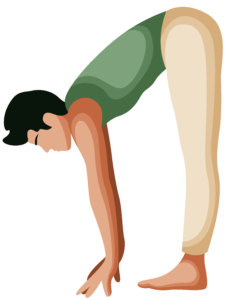Halfway Lift (Ardha Uttanasana)
Pose Overview
| Common Name | Lifted |
| Traditional Sanskrit Name | Ardha Uttanasana |
| Sanskrit Name Pronunciation | AHR-dah oo-tuh-NAH-suh-nuh |
| Pose Difficulty | Intermediate |
| Drishti
Drishti is the gaze or visual focus point during yoga poses.
Learn more about Drishti |
Tip of the nose |
The Lifted yoga pose, also known as Ardha Uttanasana, is an intermediate level backbend that requires both strength and flexibility. This pose is often used to strengthen the core, back, and arms, as well as improve balance and spinal flexibility. It is a challenging pose that requires the practitioner to engage multiple muscle groups, including the abs, back, and legs, in order to lift and hold the body off the ground.
Benefits of Lifted
Strengthen the core, back, and arms Improve balance and spinal flexibility Opens the chest and shoulders Stimulates the thyroid and pituitary glands
How to Enter Lifted
Begin in a prone position on the mat with the hands and feet on the ground. Place your hands next to your chest, fingers pointing forward. Press into your hands and feet, lifting your hips and chest off the ground. Reach your hands back and grab your heels, or hold onto your ankles if you can't reach your heels. Keep your elbows close to your body and press your chest forward. Hold the pose for several deep breaths, then release.
How to Exit Lifted
Release your hands from your heels or ankles Slowly lower your chest and hips to the mat Take a few deep breaths before moving on to the next pose.
Common Lifted Modifications & Variations
If lifting your chest and hips off the ground is too difficult, you can practice lifting your head and shoulders first, then progress to lifting your chest and hips. You can also use a wall to help support your back and legs while you practice lifting your chest and hips. For a more advanced variation, try lifting one leg at a time while holding onto your opposite ankle.
Common Mistakes with Lifted
Not engaging the core and back muscles enough, resulting in a lack of support and stability in the pose. Arching the back too much, which can put unnecessary pressure on the spine. Holding the breath during the pose, which can cause tension in the body and make it difficult to hold the pose.
Safety Guidance
Those with back or neck injuries should avoid this pose or practice with caution and under the guidance of a qualified yoga teacher. Those with high blood pressure should also practice with caution and avoid holding the pose for too long.

